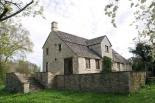That evening, we were scheduled to perform in Radovljica, about half an hour's drive from the hotel. We arrived to find a little town that looked like something from a movie set. Pristine houses with beautiful frescoes lined the town square, while the gingerbread shop, Lectar - with its lovely little hearts (lect) decorated with flowers and mottoes - is famous throughout Slovenia.
It all added to the impression that Slovenia is not quite real - it's a fantasy place, like Ruritania (if you're old enough to remember Stewart Granger in The Prisoner of Zenda) or Genovia (if you're only old enough to remember The Princess Diaries). I even saw someone wearing lederhosen.
Indeed, it seemed almost too good to be true, and I had to sit firmly on the journalistic bit of my brain, which was busily noting that there seemed to be no poor people, no rundown areas and absolutely no ethnic communities whatsoever. Being Protestant seemed to be about as multicultural as it gets in this part of the former Yugoslavia.
Historically, Slovenia is the most liberal - as well as the most wealthy - of the former Yugoslav states. After independence, however, non-Slovenian Yugoslav nationals had their residency rights rescinded. Around 30,000 people - ethnic Croats, ethnic Serbs, Bosnian Muslims, Albanian Kosovars and ethnic Roma - had their names erased from the civil registers, a move described by human rights campaigners as "administrative genocide".
Browsing in the gingerbread shop, the owner showed me a selection of mottoes which were available in English. "Home Sweet Home" and "With Love" and "From Me To You": that sort of thing. They had French versions, German versions, Italian versions - "any language you like," he said, "even Hebrew and Japanese". "And Slovenian, of course?" I said. "Yes, Slovenian," he said, laughing, adding: "For the Nazi slogans." Hmm.
Wherever you go in the world, and whatever image you might have of a place, it is odd how often the people you meet - the ordinary citizens - turn out to be charming and generous. I have Iranian and Iraqi friends, for example, who rank among the warmest, most civilised people I know. Whenever I see them, I wonder how we came to be at odds with nations that produce such affectionate, tolerant individuals.
It was the same in Slovenia. One could spend one's time feeling slightly uncomfortable about certain aspects of Slovenian history, but it seemed a bit churlish in the face of the kindness that our hosts showed towards the choir.
St Peter's was a pretty little church to match a pretty little town. There has been a church on this site since the tenth century, and this building dates from around 1500. We were intrigued to find that it was hung with garlands and wreaths and wondered whether there had been a wedding. No, we were told, the decorations were for the installation of a new parish priest the week before. Lucky priest - what a welcome.
The ceiling, in particular, was fascinating - painted with flowers both real and imagined. You could pick out a pansy, or a thistle - inspiration from the meadows and hillsides - alongside more fantastical blossoms which had flourished in the painter's fertile imagination.
Beside the church, there was the Rectory, a two-storey building built around a courtyard hung with windowboxes that overflowed with scarlet geraniums. We were shown into a large room where we could dump our stuff and change into our cassocks. Windows opened out from the corridor onto the courtyard, and to our delight, there were hummingbird moths feeding on the geraniums.
In such a small, quiet town, it was difficult to see how we were going to generate any kind of audience. (This became a recurring theme as the tour went on, always with the same result.) However, we processed into the church to find it crowded with people, and each piece of music was greeted with rapturous applause - so much so that it was sometimes difficult to start the next item.
Linhart Square in Radovljica's medieval old town, with its stone fountain and painted houses. The square is named after Anton Linhart (1756-1795), a Slovene historian and playwright, who was born in the town.
Sivec House, which has a fresco depicting the good Samaritan. Note the paint-effect stonework - many of the houses have this sort of decoration, but this was the most spectacular example.
A baroque fresco on the wall of the Koman House.
St Peter's Church, with a bust of St Peter, holding the keys to Heaven, above the door.
The green garlands inside the church were part of the decorations put up to welcome the new parish priest.
The flower-painted ceiling - some flowers are recognisable, some are imaginary.
An orchestra of angels adorns the ceiling over the central nave.
Gingerbread on sale at the Lectar House, which is also a B&B and a restaurant.
Isn't this gingerbread house sweet? I had precisely 10 minutes to get into the shop, take pictures and catch up with the rest of the choir. Just as well, really, or I would have bought the whole shop.
Many of the hearts carried mottoes, which made it even more difficult to choose. I bought four, very quickly, for me, my daughter and two of her friends, thinking they would like to keep them as souvenirs. I turned round five minutes later to see my daughter stuffing hers into her mouth.
Gingerbread hearts ready to be decorated. I tried not to think about E numbers!





















